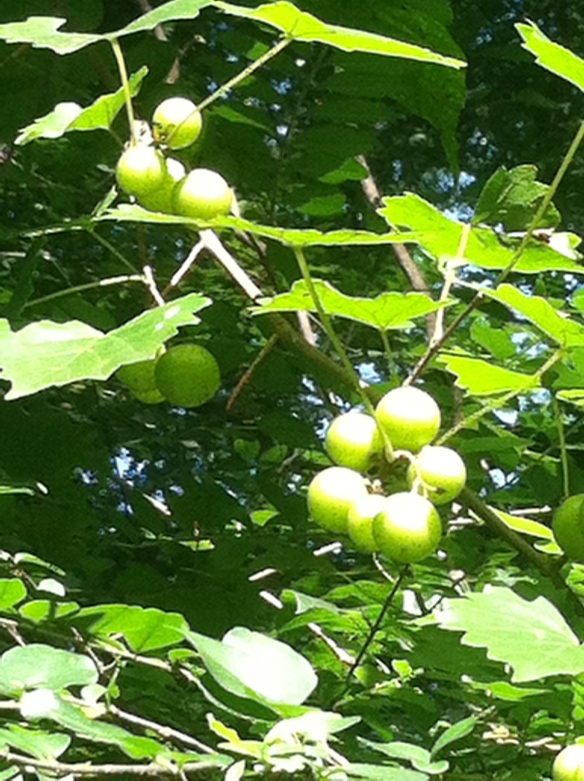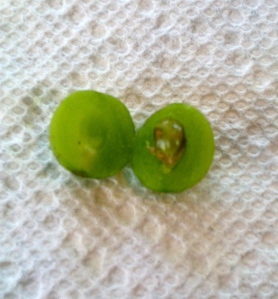Last weekend I got two books about edible plants and foraging, and after having a chance to give them both a good perusal, I’m excited about each of them but for different reasons. They’re actually nicely complementary: some of the weaknesses of one are strengths in the other. This is a longish post, so here’s the take-home message for the impatient: I’m really glad I bought both, but if I had to recommend just one, I’d go for Nature’s Garden.
1) Edible and Useful Plants of California. Charlotte Bringle Clarke, 1978.
The first thing worth noting about this book is that it’s older than I am, which means it’s been around for a long time and has been followed by a couple generations of foragers; in fact it’s one of the references for the second book I got. Since all the same plants are available now as in the 70s, the publication year isn’t really an issue–it isn’t as if the content has gone out of date.

Solid field guide to local foodstuffs. Sadly, the photos on the cover are a sizable fraction of all the photos in this otherwise excellent book.
Positives:
-Regional specificity and completeness: All the plants are found wild in California, and there are many, many entries. All the wild CA plants I’ve highlighted so far (manzanita, nettle, fennel, radish, etc) are in there, and I’ve been delighted to find that quite a few plants I recognize are in there that I never knew were edible. Field trips galore!
-Organization: She’s broken the book down into sections by type of location (mountains, coastal, urban, etc.), which will be handy for foraging.
-Recipes! For more than half of the plants mentioned, there’s a recipe given, and sometimes there are several. I’m already looking forward to fennel seed cookies, fancy nettles with bacon, oxalis lemonade, and a few dozen more for plants I’ve only ever eaten raw, or have never tried.
-Preparation and harvesting tips: It’s quite clear that she approaches plants with food in mind (as if the title and recipes weren’t a giveaway). She’s conscientious about highlighting which part of the plant is edible and how to prepare it.
-Glossary and index: there’s a very good section about nomenclature for different parts of plants. The index is sound, with entries for common name, Latin/binomial name, and use.
-Physical size: this is a little book: about 5×7″ and less than 200 pages long. Easy to put in a pocket (well…maybe for guys) or bring on a backpacking trip.
Negatives:
-Pictures. There are a handful of photographs on the front cover and a few pages of smallish photos in the center of the book, but otherwise all the plants are represented with line drawings (or in some cases, no picture at all). This is insufficient for gathering unfamiliar plants: you have to be absolutely sure a wild plant is what you think it is before you eat it. Between things like iPhones and Google images, this is not a crippling limitation: once you know what name to look for it’s easy to find lots of pictures. But you couldn’t just take this book off into the woods and be able to tell whether you have wild carrot or poison hemlock.
-Look a-likes (or lack thereof): many of the plants that are listed look similar to other, less palatable or even poisonous plants, and there’s very little attention given to what an edible plant could be mistaken for, and how to discriminate between possibilities. There’s also little attention given to the pitfalls of particular plants: elderberry is delicious to some people, but can cause bad stomach aches in others, and should be sampled cautiously. Cow parsnip is huge and can feed an army…unless you’re allergic to it and break out in blisters if you handle it.
-Organization: apart from breaking the plants down into regions where they grow, the entries seem pretty haphazard. This is not such a problem because the index is good.
Neutral/Other:
-Historical info. There’s quite a lot of discussion about which Native American tribes used the plant and for what. Because I’m mostly interested in the book as a food guide, this isn’t so much a plus for me, but it may be for others.
-Other uses: if you want plants to make into cloth or bowls or boats, you can use this book for that, too. Uses for plants other than edibility are given in many cases.
2) Nature’s Garden: A guide to identifying, harvesting and preparing edible wild plants. Samuel Thayer. 2010.

The cover has a fair sampling of the breadth of content: Blueberries, walnuts, prickly pears, oxalis...so many delicious things described with lots of pictures, careful thoroughness and a handful of funny stories.
Samuel Thayer has two books: Nature’s Garden is the sequel to Forager’s Harvest. Based on how awesome Nature’s Garden is, I’m eager to get Forager’s Harvest as well. (I just can’t help giving a word of caution, though: if you mix these two titles up in your head like I did and go looking for Natural Harvest, that will lead you to a very different book. Eww.)
Positives:
-Pictures!! There are many large photographs for almost all of the plants described. In most cases he’s been careful to include pictures of several different parts of the plant, so you’ll have a clear image of the root, stem, leaf, flower, and fruit.
-Thorough harvesting tips. There are over 20 pages on acorns alone: which species taste best, how to choose fresh acorns from old, how to spot weevil holes, several methods for how to crack them, grind them, leach them, dry them…it’s very complete. If I wanted to get into eating acorns, I could confidently use this book to get me from tree to bread. For all the plants in this book, he’s pretty conscientious about detailing which part to use, when it’s best to harvest, what differentiates a tasty example of the plant from a less-tasty one, and what tools to use to collect the best parts.
-Look a-likes: this is stellar. For plants with dangerous look a-likes, he’s put in a ton of side-by-side pictures of each part of the plant, and binary guides for telling which is which. I think anyone could confidently tell wild carrot from poison hemlock with this book. Amazingly, I found out that something I’ve been avoiding my entire life, thinking it was deadly nightshade, is actually edible black nightshade. Even for non-hazardous look a-likes there are helpful rules given for telling them apart: for example there’s a multi-part guide to telling apart all the edible members of the asteraceae family (dandelions, wild lettuce, chicory, salsify, etc).
-Glossary and index: like Clarke’s book, this book also has a very good guide (with pictures) to the names of plant parts, a glossary of all terms, and a good, cross-referenced index.
-Narrative style: It’s also a really fun read, with a chatty tone and plenty of anecdotes. I literally laughed out loud at some of the foraging myths–like the wilderness traveler who patiently explained to his native guides that eating wild food was dangerous, and how they interpreted this as him being like “We can’t eat these bananas! They are probably deadly false bananas! Doesn’t this wilderness have any labels?”
Negatives:
-Limited content. The trade-off for covering each plant in such awesome detail is that there just isn’t room to cover that many plants. I think there are about 40-50 edible plants mentioned, while I know there are actually many more than that in California alone, thanks to Clarke’s book.
-No geographical partitioning. Samuel grew up in the Midwest, and all the plants he introduces can be found there, but only 75% can be found in CA. Apart from giving this overall percentage of how many of these plants are found in each state, and general environmental preferences for each plant, he doesn’t usually really clarify which plants can be found where.
-No recipes. Lots of detail on which part of the plant to pick and what kinds of food it’s good for (flour, cooked greens, seasoning…), but no real recipes.
-Physical size: it’s a bit bigger, maybe 7X9″–so it would totally fit in a backpack but not a pocket.
Whew! Ok. That was a lot of words, but I hope you find them useful. If anyone wants to get together for a foraging trip and try these books out I am totally game!


































